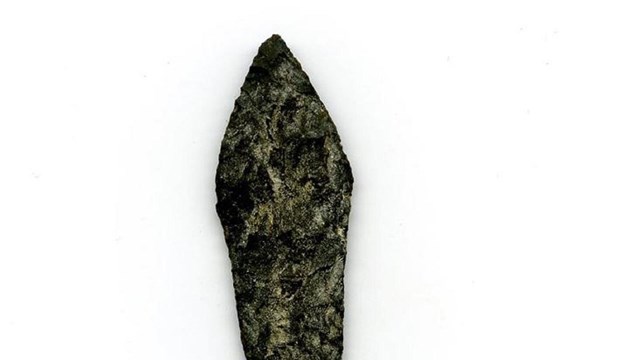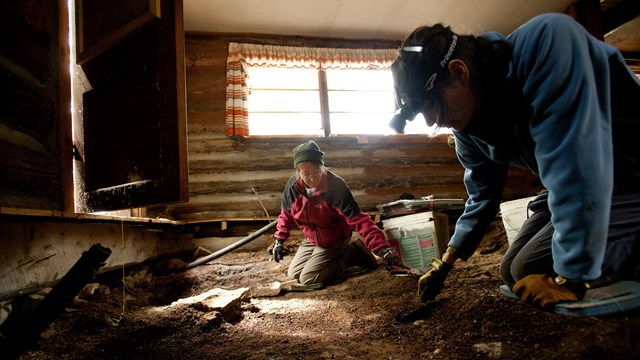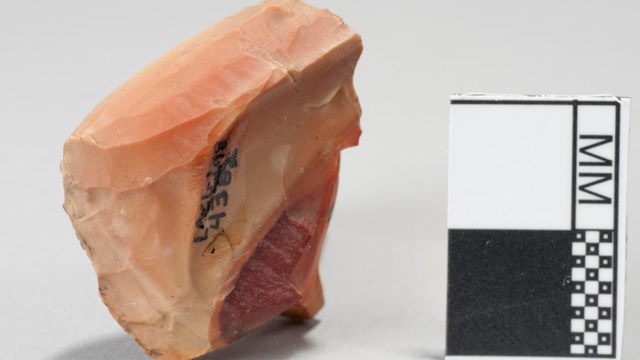|
Q: What is an archeological site? Mention archeology and most people think of the Egyptian Pyramids or Stonehenge, but there are many places and objects that can be considered archeological. A site is any location that contains evidence of past human activity. Southwest Alaska's pre-contact sites include the ancient shell-filled villages that dot the coast, burial caves in secluded mountain settings, stone weirs built to trap salmon, ridge top camps, stone quarries, and even the ancient trails linking regions. The region also holds historic, or post-contact, sites. The Kijik Archeological District in Lake Clark National Park is a National Historic Landmark amd reflects a significant period of American history. Trappers' cabins, cannery sites, and trails are also important post-contact sites. Q: What is an artifact? An artifact is any object from an archeological site that displays human modification. This can include finished tools or the debris created by making tools. Artifacts can tell interesting stories, but this story is richer if the location of the artifact in a site is known. Did the artifact come from someone's house or from their garbage? What types of artifacts were found nearby? These are some of the questions archeologists ask. Q: Why are archeological sites important? Throughout the world, the period of written history is very brief. There are many thousands of years for which there is no written record. Southwest Alaska has been inhabited for more than 7,500 years, but you can only read about the past 250 years. For many long periods of human history, archeological sites are the only source of information. Also, sites contain important geological and biological information that is difficult or impossible to find elsewhere. Archeological sites are like library books. They are accumulations of information, and each holds a unique story. Q: Who owns archeological sites and artifacts? Archeological sites and the artifacts they contain belong to the owner of the land on which they occur. In Alaska, artifacts found in the tidal zone (on the beach) or on submerged lands belong to the State. It is also important to recognize that Native American people feel very strong ties to materials made by their ancestors. To many, these artifacts are sacred and belong to the Native community. Q: Who can dig an archeological site? All professional archeologists arrange permits before conducting any excavation or collection. These permits state how materials will be obtained and where they will be stored. Under the Archaeological Resource Protection Act of 1979, it is illegal to dig in, or to take, purchase, sell, receive, or transport materials from a site on federal land without a permit. Similar laws protect state and private lands, and Native American burials. Damage to a site on federal lands that exceeds $500 is considered a felony and can result in the seizure of any vehicle (car, truck, fishing vessel, plane, RV) used in the crime, fines of up to $250,000, and up to five years in prison. Q: What does recreational digging do to an archeological site? Recreational digging is enormously destructive because much of the information stored in a site is lost when excavation proceeds unscientifically. Artifacts are removed from their location in a site and delicate materials are destroyed. Moreover, artifacts taken for private collections are lost to history. The information they contain cannot be shared with Native people, the scientific community, or the public. Archeological sites are a non-renewable resource. Once disturbed, they cannot be repaired. Recreational digging is like ripping pages from a history book. It damages the site and limits interpretation. Q: Can I collect artifacts if I bring them to a museum? No. Most museums cannot accept artifacts collected illegally (i.e., without the permission of the landowner). This would be equivalent to accepting stolen property. Q: What can I do to preserve Alaska's past? Set a good example. Never dig in an archeological site or collect artifacts except under the guidance of a professional archeologist. Leave any artifact you find in place and report it to an archeologist. This will allow the archeologist to contact the landowner about saving the artifact and to document its precise location. Teach your family and friends about the importance of site preservation. Most people have no idea that recreational digging is destructive and illegal. Report acts of site vandalism or illegal artifact trade to the National Park Service (1-800-478-2724) or the Alaska State Troopers. Rewards of up to $500 are available for information leading to a civil or criminal conviction under the Archaeological Resources Protection Act. This information was developed by the Alutiiq Museum and Archeological Repository in Kodiak, Alaska and modified by the Cultural Resources Programs at Lake Clark National Park and Preserve. 
Why Archeologists Value Context
Context give archeologists a more complete picture of the past. 
Ice Patch Archeology
High elevation areas where ice patches form are not frequented by a significant number of people today, but what about in the past? 
Preserving Archeological Sites and More
What park staff are doing to preserve archeological sites and cultural landscapes. 
Is This the Park's Oldest Artifact?
Is the the oldest object in the park collections? Was it found at the oldest archaeological site in the park? |
Last updated: April 23, 2019
